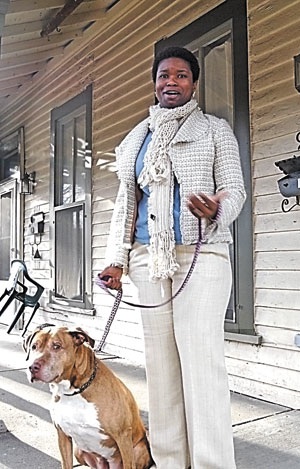City Gallery Links Residents to Urban Neighborhoods
This piece is reprinted from the February 23, 2012 edition of the Indianapolis Recorder
Jessica Williams-Gibson As you pass by the Harrison Center for the Arts on 16th and Delaware, initially you may be confused. What was once the historic First Presbyterian Church now houses various art programs, local artists and art galleries. Dig a little deeper and you’ll find that the Harrison Center in that space makes perfect sense as the center strives to foster awareness and appreciation for arts and local culture. Once inside the building, one may experience similar feelings towards City Gallery. Anchored by a large plush sofa flanked by small tables, a large window facing Delaware Street and paintings on the walls, upon first look City Gallery is your typical art gallery.
Looking closer, it is actually the newest program of the Harrison Center that uses arts and culture to tell the story of Indy’s urban neighborhoods. These stories include the location where Sen. Robert Kennedy delivered the news of Dr. Martin Luther King’s death in what’s now called King Park area or that Herron Morton Place was once the location of the Indiana State Fairgrounds during the Civil War among other countless stories. “We want people of Indianapolis to know the name of their neighborhood and where they’re from and have pride. We want to create a movement that celebrates culture, community and place,” said Joanna Taft, executive director of the Harrison Center. The gallery partially accomplishes its goal through artwork depicting the flavor and uniqueness of Indianapolis’ urban neighborhoods such as Fletcher Place, Ransom Place and New Augusta. Most importantly, City Gallery acts as a resource center, connecting community developers, real estate firms, homeownership advisors and current homeowners to people who want information on urban neighborhoods or are looking for housing opportunities.
Taft and her staff are currently informing potential urban homeowners and renters of the Neighborhood Stabilization Program. This federal program provides eligible homebuyers with subsidies on new and rehabbed homes in neighborhoods such as Mapleton-Fall Creek, the Near Eastside and Old Northside. “There’s a time limit on this program. It expires in the spring of 2013,” said Taft. Lorraine Phillips Vavul, chair of the Historic Urban Neighborhoods of Indianapolis says that although Indianapolis has more than 25 historic neighborhoods in its urban core, many of these area’s homes are old and require some work. Some of these neighborhoods have already been redeveloped, such as Lockerbie Square and others are currently being developed such as the neighborhood near the Children’s Museum of Indianapolis. Select community development corporations are working to refurbish homes or offer grants to help fix properties.
Vavul understands that many of these urban neighborhoods also have issues such as abandoned homes and crime, but argues urban areas shouldn’t be singled out – all areas of Indianapolis face similar problems. She also hopes an influx of new residents will help elevate urban neighborhoods and improve its historic, aesthetic and social value. “It’s really important to keep residents in Marion County so that we can have a good tax base and a good public school system and public safety system,” added Taft who’s lived near 20th and New Jersey for over 20 years.
Neither Vavul nor Taft suggest that suburban flight or suburban conveniences is wrong. They do, however, believe the pros outweigh the cons - close-knit areas that have a greater sense of community, fellowship and camaraderie and the same amenities as the suburbs. “We all know each other. We have dinners at each other’s homes – it’s very warm and a great community. We’ve even formed a small neighborhood association,” said Bernice Corley a resident of the up and coming Fountain Square area. She and her family moved to that area because of its affordability, close proximity to her job and diversity. She hopes others realize the value of city life and describes it as a great experience.
Maurice Broaddus and his family are considering moving from Eagle Creek to Fountain Square. As an author, he loves the eclectic and artistic feel of Fountain Square and wants his sons, Reese and Malcolm, to grow up in an intimate neighborhood. “I’ve actually plotted several novels here. I drive (to Fountain Square) to write all the time,” said Broaddus as he greets locals entering the Calvin Fletcher coffee shop located on Virginia Avenue. “My wife reminds me of the security we have living in Eagle Creek, but she has friends here too, so she’s coming around.”
While Blacks such as Corley and Broaddus have embraced urban living, many community developers know that they have a huge task in front of them – changing the negative perception of historic urban areas such as Haughville. “If you really want to see what a neighborhood is all about, hang out at a local coffee shop or restaurant. They know the regulars and can tell you what the neighborhood is all about,” said Broaddus.

